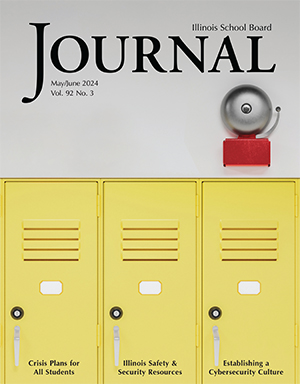 Front Page: In the Shadow
Front Page: In the Shadow
By Theresa Kelly Gegen
Journal | May/June 2024
At a recent Division Meeting, the guest speakers mentioned that it had been 25 years since the school shooting at Columbine High School in Littleton, Colorado.
It’s true. The tragedy now known simply as Columbine took place on April 20, 1999. But 25 years still seems wrong.
It seems wrong, of course, because as with all things time, we perceive those 25 years to have passed so quickly.
On the other hand, it also seems wrong because we perceive we have been living in the shadow of Columbine for much longer. For forever.
Columbine, when it happened, was not the worst mass casualty incident at a school, or even the first school shooting, but it occurred during a golden age of live television news coverage, between the Space Shuttle Challenger disaster and 9/11, when people still watched the news for news. We experienced those moments — shock, confusion, grief — together but on TV. Fifteen people died at Columbine: 12 students, one teacher, and the two shooters, both of whom were also students at Columbine High School. It was the deadliest mass shooting at a high school in U.S. history until it was surpassed in February 2018 by the Marjory Stoneman Douglas High School shooting in Florida. Sandy Hook, Santa Fe, Uvalde, Oxford — there are more but today we don’t always hear about them unless the death toll is high.
The guest speakers who mentioned Columbine were Eric Arnold, Illinois School and Campus Safety Program Director for the Illinois Law Enforcement Training and Standards Board Executive Institute at Western Illinois University, and David Saitta, NIMS/ICS Program Manager for the Illinois Fire Service Institute at the University of Illinois. They team up to bring information on the Illinois School and Campus Safety Program to the education community — including to IASB Division Meetings and the Joint Annual Conference. On that night, they spoke about Active Shooter Incident Management, including developing a command structure and preparation with a focus on reunification. The Illinois School and Campus Safety Program features collaborations among a wide range of state agencies to provide training and resources on every school safety subject you can imagine, and some you can’t.
As terrible as they are, school shootings aren’t the only threats to schools and the people in them. In 1967, students in Belvidere schools were killed and more injured when a tornado struck as schools were letting out. In 1995, seven Cary-Grove High School students were killed when their school bus failed to clear a crossing and was hit by a commuter train. And of course, in 2020 the world and Illinois schools experienced the life-altering COVID-19 pandemic, the direct impacts of which are being felt four years later.
We would be failing the victims of school tragedies if we did not learn from them. Columbine prompted a wave of conversation and an entire industry of threat assessment and prevention methodologies for violent incidents at schools. It opened up space in the national conversation for all safety and security topics. IASB hopes its members will continue to participate, to learn, and to have local conversations about school safety and security.
Theresa Kelly Gegen is the Editor of the Illinois School Board Journal and can be reached at tgegen@iasb.com.